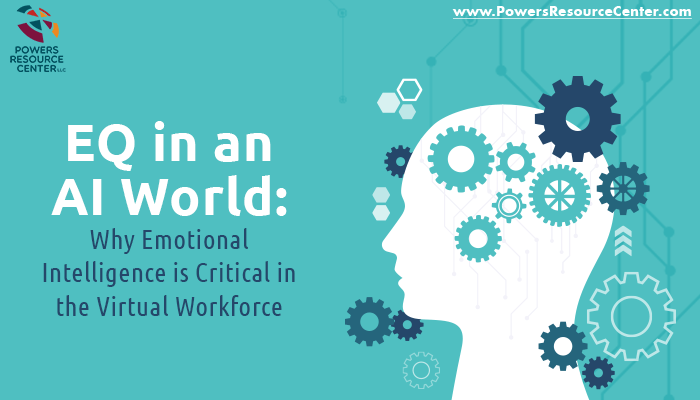The advancements in artificial intelligence are staggering – self-driving cars, digital personal assistants like Siri and Alexa. Heck, IBM’s Watson is solving medical cases that have stumped doctors for years.
Looking beyond the sci-fi hype, I’ve been doing a lot of thinking about what AI means for the workplace. Sure, we’ll all in favor of increased efficiency, improved processes and letting the machines take on the more tedious aspects of our jobs. But how do we retain our value in an AI world? How do we ensure that our very humanness stays relevant as learning machines get smarter and smarter? What skills will be the most useful before the machines take over? (Just kidding ;-) What do we need to focus on above capital appreciation?
I think I have the answer. I believe that in our increasingly disconnected, virtual work environments, it will be the organizations that recognize the importance of human connection and emotional intelligence that will rise to the top.
Emotional Intelligence
As described in the Harvard Business Review article, The Rise of AI Makes Emotional Intelligence More Important, those who want to “stay relevant in their professions will need to focus on skills and capabilities that artificial intelligence has trouble replicating — understanding, motivating, and interacting with human beings.” In other words, emotional intelligence. Plug in to that.
This article is speaking my language.
Emotional intelligence is the key to setting yourself apart in an AI world. Emotional intelligence, or emotional quotient (EQ), is the ability to identify and manage your own emotions and the emotions of others. Basically, it is having emotional awareness and the ability to harness emotions and apply them to things like problem-solving. It’s empathy, persuasion, observation and understanding; it’s the ability to motivate a team, dodge political hot buttons and identify the right people for the right roles. This is innately human and not machine learning. IBM Watson can’t do that.
Some AI powered voice assistants, like Amazon’s Alexa and Apple’s Siri, are equipped with audio analysis capabilities to recognize and respond to emotional cues in users’ voices, adapting their responses accordingly. And we can’t deny that they are a great mastering assistant. However, though they can pick up on audio analysis cues, they can’t respond with empathy or compassion. As much as AI tools are being programmed to learn emotional intelligence, it’s no replacement for the real thing. In today’s workplace, we are already out of practice picking up on the visual cues, non-verbal behaviors and body language that help us communicate clearly and interpret the emotions of the people around us. You need to keep your human EI and EQ skills sharp.
How to build Emotional Intelligence
The best starting point that I have found to create emotional intelligence awareness is through DiSC Certification and Wiley’s Everything DiSC suite of products. It provides unbiased language for people to talk about their own strengths and weaknesses and understand people’s behavioral differences. Any investment advisor will tell you how valuable EQ is as an asset. Support your team’s EI in an AI world!
In this era of rapid technological advancement and the growing presence of AI powered tools, it is evident that emotional intelligence (EQ) remains more critical than ever. As the article rightly points out, amidst the dominance of AI powered solutions, the human touch and our intrinsic emotional intelligence stand out as differentiating factors. Emotional intelligence equips individuals to skillfully navigate the intricate landscape of human emotions, a proficiency that machines struggle to replicate. No filter curve can make up for the complexity of human emotion.
While Artificial Intelligence makes commendable progress in understanding and emulating emotions, it is dwarfed by the depth and subtlety of human emotional intelligence. Advanced as machine learning is, like IBM Watson may be in processing power, they fall short when it comes to the nuances of empathy, persuasion, and interpersonal understanding—qualities that set humans apart as effective communicators and leaders. You can’t simply press an AI powered record button and learn the nuances of emotional intelligence if you are a machine. In today’s increasingly virtual and disconnected work environments, it’s imperative to invest in cultivating and preserving our emotional intelligence.
(Want to see how good your EQ is? Take this quiz on Emotional Intelligence from the Haas School of Business at UC Berkeley.)
This can be achieved through tools like DiSC Certification and Wiley’s Everything DiSC suite, which provide a structured approach to enhancing EQ while enhancing our understanding of human behaviors. As we embrace the Artificial Intelligence age, we must not overlook the irreplaceable value of our human capacity to connect, empathize, and comprehend one another. Hi the record button on that!
Our Emotional Intelligence training program for managers and leaders shows them how to connect with colleagues and teammates more effectively.
Related Posts
-
How To Elevate Leadership with Emotional Intelligence
Unlock Success With Our Done-for-You Employee Training Content Exceptional leaders are distinguished not only by their technical skills but also by their ability to navigate the complex world of emotions. Emotional intelligence (EQ) plays a pivotal role in fostering effective leadership and driving success in…
-
How To Elevate Leadership with Emotional Intelligence
Unlock Success With Our Done-for-You Employee Training Content Exceptional leaders are distinguished not only by their technical skills but also by their ability to navigate the complex world of emotions. Emotional intelligence (EQ) plays a pivotal role in fostering effective leadership and driving success in…
-
How To Elevate Leadership with Emotional Intelligence
Unlock Success With Our Done-for-You Employee Training Content Exceptional leaders are distinguished not only by their technical skills but also by their ability to navigate the complex world of emotions. Emotional intelligence (EQ) plays a pivotal role in fostering effective leadership and driving success in…





